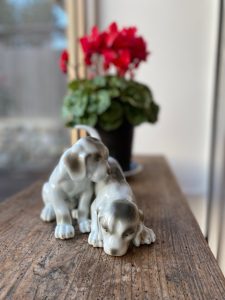赤い実の植物の名前(愛知県名古屋市千種区姫池通 古美術風光舎 名古屋店 骨董・古道具買取いたします)
2021.12.21
みなさま、こんにちは。
一昨日のスタッフYさんのブログに登場した大王松ですが、私もいただけることになりまして、どうやってアレンジしようか、ワクワクと考えているスタッフMです。
「赤い実を飾ろうかしら、稲穂も一緒がいいな、水引で飾ってもかわいいし・・・」
なんてアレンジの写真を見てはニヤニヤ構想を練っています。

ところで、この赤い実、最近ポスティングでご近所を歩き回っているとよく見かけますが、
それが千両なのか、南天なのか、はたまた違う名前なのか植物に詳しくない私は見分けがつきません。
そこで、せっかくの機会ですので調べてみました。
「センリョウ」
お正月によく見かけるこのセンリョウは、背丈は1メートルもない低木で、ギザギザの葉の中央に赤い実がつくそうです。
山林の湿った半日陰地に自生する常緑小低木で、別名「草珊瑚」と呼ばれるほど鮮やかな赤い実を11月頃に熟させ、冬の庭木として明るい彩りを添えてくれます。
センリョウの実付きの枝ものは、千両という名前から、万両とともに正月の縁起物の切り花として利用されるようです。
「マンリョウ」
上記にもありますが、名前がおめでたいことから「千両」と一緒に並ぶことが多い「万両」。
背丈はセンリョウと同じくらいですが、マンリョウは葉の下に赤い実がつき、幹をぐるりと囲うように実るようです。
葉のふちは、センリョウのように少しギザギザしています。
でも、センリョウがセンリョウ科なのに対し、マンリョウはサクラソウ科なので、種類も全く違う植物なんだそうですよ。(他人の空似ですかね・・・。人ではありませんが。)
では、なぜ千両よりも額の大きい万両と名がついたのか、気になりませんか?
実は、センリョウよりも実が大きいためだそうです。
私は、並べて見てみないと実の大きさの大小はわからないかもしれません。
「ナンテン」
「難を転じる」と言われ、庭木に多く使われてきたナンテンは、日が当たりにくい場所でもよく育つので、家の北側の方に植えられていることが多いようです。
また、ナンテンは背丈が1~2メートルほどの低木で、赤い実はブドウの軸をひっくり返したような形になるようです。
センリョウやマンリョウよりも葉は小さく、ギザギザしていないナンテンは、冬になると葉も赤く紅葉し次第に落葉します。寺社仏閣などでもよく目にします。
また、縁起物として好まれ、古くから魔除け、厄除け、無病息災を願い多くの家庭で栽培されてきたそうです。
なんと江戸時代から人気の古典園芸植物の一つです。
鑑賞するだけではなく、民間薬としても利用されてきました。
南天の実を焼酎、氷砂糖とともに漬け込んだ南天酒は、咳止めの効用があるようです。
南天のど飴も有名ですものね。
他にも、熱い食べ物の上に南天の葉をのせて蓋をすると、微量の腐敗を防ぐ成分が出るため、お赤飯の上に乗せられている南天の葉は縁起物の意味だけでなく、防腐として役立っているようです。
その他にも、赤い実がなる木はまだまだたくさんあるようで、「ヤマボウシ」「モッコク」「アオハダ」「モチノキ」「ウメモドキ」「ガマズミ」「オオカメノキ」「アキグミ」「シロダモ」「カナメモチ」「クロガネモチ」「ナナミノキ」・・・なんて名前を上げたら切りがないくらいありました。
冬に赤い実が多く見られる理由は、諸説あるようですが、鳥たちが上空から見た時に、緑の葉が落ちた中で赤は目立ってよく食べてもらえるため、などと言われているそうです。
長い長い年月の中で、植物も子孫を残すために、以前は違う色だったけれど、こぞって赤い実をつけるようになっていったのでしょうかね。
人間にとっても、寒い季節に赤い植物を見つけることは、目から温もりを感じることにつながり、どことなく安心するし、元気ももらえます。
そんなわけで、本日は私の調べものにお付き合いいただきました。
お読みいただきありがとうございました。
(スタッフM)
Hello everyone.
Longleaf pine that appeared on the blog of staff Y the day before yesterday, but I am also excited about how to arrange it.
“I wonder if I should decorate the red fruit, I like the rice ears together, it’s cute even if I decorate it with Mizuhiki …”
Looking at the photos of the arrangement, I have a grinning idea.
By the way, I often see this red fruit walking around the neighborhood by posting recently.
I can’t tell if it’s a thousand cars, a southern sky, or a different name, because I’m not familiar with plants.
So, it was a great opportunity, so I looked it up.
“Sarcandra glabra”
This sarcandra glabra, which is often seen on New Year’s Day, is a shrub that is less than a meter tall and has red fruits in the center of the jagged leaves.
It is an evergreen small shrub that grows naturally in the moist half-shade area of the forest. It ripens bright red fruits around November, which is also known as “grass coral”, and adds a bright color as a winter garden tree.
The branch with the fruit of Sarcandra glabra seems to be used as a cut flower of the lucky charm of the New Year together with 10,000 cars from the name of Senryo.
“Manryo”
As mentioned above, “Manryo” is often lined up with “Senryo” because of its congratulations on its name.
The height is about the same as that of Sarcandra glabra, but Manryo has red fruits under the leaves and seems to grow around the trunk.
The edges of the leaves are slightly jagged like sarcandra glabra.
However, while Chloranthaceae belongs to the family Chloranthaceae, Ardisia crenata belongs to the family Primroses, so it seems that the species are completely different. (Isn’t it like someone else’s? … I’m not a person.)
So, don’t you wonder why it was named 10,000 cars, which is bigger than 1,000 cars?
Actually, it seems that it is because the fruit is bigger than Senryo.
I may not know the size of the actual size unless I look side by side.
“Nandina”
Nandina, which is said to “turn the trouble” and is often used for garden trees, grows well even in places where it is hard to get sunlight, so it seems that it is often planted on the north side of the house.
In addition, nandina is a shrub with a height of about 1 to 2 meters, and the red fruit seems to be shaped like an inverted grape axis.
The leaves are smaller than those of Sarcandra glabra and Ardisia crenata, and the non-jagged nandina leaves turn red and gradually fall in winter. I often see it in temples and shrines.
In addition, it is popular as a lucky charm and has been cultivated in many households for a long time, hoping for amulets, amulets, and disease-free breathing.
It is one of the popular classical garden plants since the Edo period.
It has been used not only for appreciation but also as a folk medicine.
Nandina liquor, which is made by soaking Nandina fruit with shochu and rock candy, seems to have a cough-preventing effect.
The southern throat lozenges are also famous.
In addition, if you put the leaves of the southern sky on hot food and cover it, a small amount of ingredients that prevent spoilage will come out, so the leaves of the southern sky on the red rice are not only a lucky charm but also an antiseptic. Seems to be useful as.
In addition, there seem to be many more trees that bear red fruits, such as “Yamaboshi”, “Ternstroemia”, “Ilex macropoda”, “Ilex serrata”, “Ilex serrata”, “Gamazumi”, “Okamenoki”, “Akigumi”, “Shirodamo”, “Ilex rotunda”, and “Ilex rotunda”. “Nana Minoki” … I couldn’t help but name it.
There are various theories as to why many red fruits are seen in winter, but it is said that when birds see from the sky, red is conspicuously eaten while the green leaves have fallen. that’s right.
Over the years, plants also had different colors in order to leave offspring, but I wonder if they all began to bear red fruits.
For humans, finding red plants in the cold season leads to a feeling of warmth from the eyes, which is somewhat reassuring and energizing.
That’s why I got to know my research today.
Thank you for reading.
(Staff M)
**********************
このところのいよいよ寒くなって参りましたね。
生活様式の変化とともに、大切なお品を整理されている方も多いことと思われます。
ここ風光舎では、古美術品や骨董品の他にも絵画や宝石、趣味のお品など様々なジャンルのものを買受しております。
お片付けをされていて、こういうものでもいいのかしらと迷われているものでも、どうぞお気軽にご相談下さいませ。
風光舎は、出張買取も強化しております。
愛知県内はもちろん、岐阜県・三重県その他の県へも出張いたします。
どんなにご近所の方でもお伺いできますので、まずはお電話お待ちしております。
愛知県名古屋市千種区・骨董 買取
『古美術 風光舎 名古屋店』
TEL 052(734)8444
10:00-17:00 OPEN

